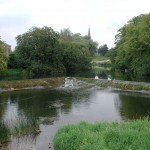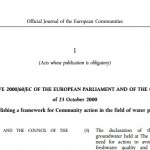'Hydrometrics’ is the measurement of water levels and flow -…
Natural Water Retention Measures – implementing the Flood Risk Management Plans
Conor Galvin from the OPW tells us about how Natural Water Retention Measures can deliver multiple environmental benefits for habitats, carbon sequestration, water quality, flood mitigation and public amenity.
Natural Water Retention Measures (NWRM) are multi-functional measures that aim to protect water resources and address waterrelated challenges by restoring or maintaining ecosystems as well as natural features and characteristics of water bodies using natural means and processes (1).
Typical NWRM include riparian woodlands, agricultural and upland drainage modifications, non-floodplain wetlands, instream structures (e.g. large woody debris), and offline storage ponds.

It has been demonstrated that NWRM improve water quality and can be effective at reducing flooding in small catchments for frequent floods, that is, in catchments less than 10km2 and for floods with a one in ten chance of occurring in any given year. NWRM also achieve multiple benefits beyond water quality and flood risk reduction, including habitat creation, climate regulation, and the provision of amenity.
The benefits and appropriate application of NWRM are extensively documented in the Scottish Environment Protection Agency Natural Flood Management Handbook, the Environment Agency (UK) Working with Natural Processes Handbook, and the EU Commissions NWRM web-portal.

As the lead State body for the coordination and implementation of Government policy on the management of flood risk in Ireland the Office of Public Works (OPW) recognise that NWRM has a part to play in managing flood risk. In May 2018 Minister of State with special responsibility for the OPW and Flood Relief, Kevin ‘Boxer’ Moran T.D. published 29 Flood Risk Management Plans to address flood risk in Ireland. The Government has committed almost €1bn to implement the measures in the plans as part of the National Development Plan 2018-2027. The Plans, which set out the whole of Government approach to managing flood risk, all have a specific measure regarding NWRM as follows:
‘The OPW will work with the Environment Protection Agency, Local Authorities and other agencies during the project-level assessments of physical works and more broadly at a catchmentlevel to identify any measures, such as natural water retention measures (such as restoration of wetlands and woodlands), that can have benefits for Water Framework Directive, flood risk management and biodiversity objectives.’
The OPW are progressing with three actions to implement this measure; delivering Flood Relief Schemes, the NWRM Working Group, and Research and Pilot Studies.
Flood Relief Schemes
The OPW in partnership with the respective Local Authorities are currently progressing 57 of the 118 Floor Relief Schemes recommended in the Flood Risk Management Plans.
The first in a five-stage process to deliver a flood relief scheme is to carry out scheme development and design, building upon the work already carried out in the National Catchment Flood Risk and Mapping (CFRAM) Programme. During this phase, the scheme designers are required to carry out a NWRM feasibility assessment. This assessment will look at the feasibility of NWRM to form part of the flood relief scheme and also at the potential to achieve co-benefits.
The progression of these flood relief schemes is an opportunity for the implementation of NWRM to complement traditional engineering solutions.
Natural Water Retention Measures Working Group
A NWRM Working Group has been established to advise the Water Framework Directive (WFD) National Technical Implementation Group (NTIG) on proposals for including NWRM as part of a broader suite of mitigation measures that could contribute to the achievement of environmental objectives set out in the second RBMP.
The group has met three times in 2019 and includes a broad range of stakeholders reflecting the wide range of land use types covered by NWRM and also the multiple functions and co-benefits that they can provide.
Natural Water Retention Measures Research and Pilot Studies
The principal NWRM research being undertaken in Ireland is the SLOWWATERS project: A Strategic Look at Natural Water Retention Measures. This four-year research project, which is being carried out under the EPA Research Programme’s Water Research Call 2018, commenced in February 2019 and has a budget of €508,000 jointly funded by the OPW and the EPA.
The research will assess the benefits of NWRM for agricultural catchments in Ireland. The project outputs will provide recommendations for the management of specific catchment types relevant to the Irish environment by quantifying the magnitude of NWRM required to reduce flood peaks. Two demonstration sites in Cork and Wexford will show how to design, build and monitor the performance of NWRM. It is envisaged that the demonstration sites will be visited by numerous stakeholder groups to evaluate the practicalities of uptake of NWRM on Irish farms.
The research is being led by Professor Mary Bourke of Trinity College Dublin and the team includes authors of the Environment Agency (UK) Working with Natural Processes – Evidence Directory from Newcastle University and The James Hutton Institute in Scotland as well as participants from University College Cork.
Research is also being carried out to assess the effectiveness and potential for NWRM in forested catchments in Ireland. The OPW through the Irish Research Council Enterprise Partnership Scheme are co-funding a PhD research study, titled The ecosystem services of Ireland’s forests for flood protection and water quality. The aim of the project is to test the potential role of specifically-designed NWRM within conifer plantations to attenuate the flux of water, sediment and soluble pollutants to receiving waters and thereby the potential to further reduce the flood risk and environmental impact of forestry operations to sensitive catchments. This research commenced in March 2019 and will use GIS-based mapping techniques, hydrological modelling, and full-scale field demonstration sites.
The OPW have also provided funding to the Inishowen River Trust to assess the feasibility of implementing NWRM in Inishowen. This assessment includes mapping sites with the potential to implement measures such as large woody debris dams, peat drain blockage, and floodplain storage.
Outcomes
Through these three actions the NWRM measure in our Flood
Risk Management Plans will provide us with an additional suite of
measures to compliment traditional engineering solutions to flood risk
management while also achieving multiple benefits in other sectors.
Conor Galvin, Flood Risk Assessment and Management, Office of Public Works
Learn more:
(1) EU Commission (2014), Policy document on Natural Water Retention Measures
The OPWs national flood information portal provides location specific access to flood risk and flood management information: www.floodinfo.ie
EU NWRM web-portal: www.nwrm.eu
SEPA Natural Flood Management Handbook: www.sepa.org.uk/media/163560/sepa-natural-floodmanagement- handbook1.pdf
EA Working with Natural Processes – Evidence Directory: www. gov.uk/government/publications/working-with-natural-processes-to-reduce-flood-risk
Inishowen Rivers Trust Slow the Flow event: www.catchments.ie/ slow-the-flow-natural-flood-management-in-inishowen/







